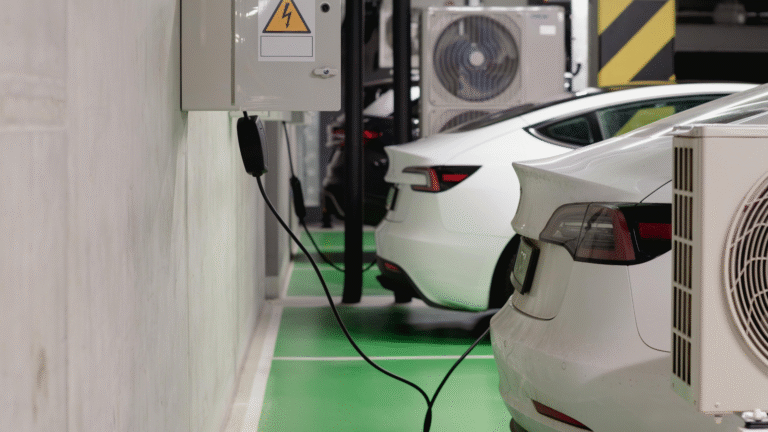Electric vehicles (EVs) are often hailed as a clean alternative to petrol-powered cars, but some critics argue that manufacturing an EV—particularly its battery—creates a larger carbon footprint than building a traditional car. So, what’s fact, and what’s fiction?
For Australian drivers looking to make a sustainable choice, understanding the true environmental impact of EV production is essential. In this article, we separate myth from reality to help you assess the full lifecycle footprint of an electric vehicle.
—
Table of Contents
- Why the Carbon Footprint of Manufacturing Matters
- Myth #1: EVs Have a Bigger Carbon Footprint Than Petrol Cars
- Myth #2: EV Batteries Are Environmentally Disastrous to Produce
- The Lifecycle Emissions Picture: EVs vs. ICE Vehicles
- Australia’s EV Supply Chain and Emissions Context
- How the Industry Is Reducing EV Manufacturing Emissions
- FAQs
- Conclusion
—
1. Why the Carbon Footprint of Manufacturing Matters
Most of an electric vehicle’s environmental benefit comes during its operational life—when it produces zero tailpipe emissions. However, manufacturing EVs, especially their lithium-ion batteries, is energy-intensive.
Understanding where those emissions come from and how they compare to the lifecycle emissions of internal combustion engine (ICE) vehicles is key to making informed, sustainable transport choices.
—
2. Myth #1: EVs Have a Bigger Carbon Footprint Than Petrol Cars
❌ False, but with nuance.
It’s true that producing an EV generally results in more greenhouse gas emissions than building a petrol car—mainly due to battery production. However, once the car hits the road, the comparison shifts dramatically.
📊 Studies consistently show:
- EVs “pay back” their higher manufacturing emissions within 1.5–2 years of average driving.
- Over a 10-year lifespan, EVs emit up to 50% less CO₂ than ICE vehicles—even on a fossil-fuel-heavy grid.
🔍 Example:
According to a 2023 study by the International Council on Clean Transportation (ICCT), EVs in Australia produce about 30–50% fewer lifecycle emissions than petrol cars, depending on the state’s energy mix.
—
3. Myth #2: EV Batteries Are Environmentally Disastrous to Produce
⚠️ Partly true, but improving rapidly.
Producing lithium, cobalt, and nickel for EV batteries involves mining, which has environmental and ethical concerns. However:
- Manufacturers are shifting to lower-impact sources and improving traceability.
- Battery chemistries are evolving (e.g. LFP batteries with no cobalt or nickel).
- Many automakers now use renewable energy in their factories and battery plants.
🇦🇺 Did You Know?
Australia is a major global supplier of lithium, offering an opportunity to lead in responsibly sourced, lower-emission battery materials.
—
4. The Lifecycle Emissions Picture: EVs vs. ICE Vehicles
Here’s how EVs stack up over their entire life cycle:
| Lifecycle Stage | EV (AUS Avg.) | Petrol Vehicle |
|---|---|---|
| Manufacturing | Higher (esp. battery) | Lower |
| Operation (driving) | Much lower | High (tailpipe emissions) |
| Maintenance | Lower (fewer parts) | Higher (fluids, filters) |
| End-of-life recycling | Improving | Established, but polluting |
| Total Lifecycle CO₂ | 30–50% lower overall | Baseline |
⚡ With Australia’s grid steadily shifting to renewables, EV operational emissions will continue to drop.
—
5. Australia’s EV Supply Chain and Emissions Context
🇦🇺 Australia’s grid varies significantly by state:
- Tasmania and South Australia have high renewables (hydro, wind, solar).
- NSW and VIC are transitioning from coal.
- Charging your EV in SA or TAS results in dramatically lower operational emissions.
🇦🇺 Local opportunities:
- Australia is uniquely positioned to supply lithium, graphite, and rare earths with better environmental controls.
- Domestic battery manufacturing and vehicle assembly (e.g. in Victoria and WA) could reduce shipping-related emissions.
—
6. How the Industry Is Reducing EV Manufacturing Emissions
Manufacturers are actively working to cut emissions at the source. Key strategies include:
♻️ Renewable-powered factories:
- Tesla, BMW, and Polestar run battery or vehicle production using solar or wind.
🔋 Battery recycling and reuse:
- Companies like Redwood Materials and Australian startups are improving battery circularity.
- End-of-life batteries may be reused in stationary energy storage.
📦 Sustainable materials:
- EV interiors now feature recycled plastics, bio-based fabrics, and ethically sourced metals.
—
7. FAQs
🛻 Do electric utes and SUVs have a higher carbon footprint than small EVs?
Yes—larger vehicles use more materials and energy. However, they still outperform equivalent petrol utes in lifetime emissions.
🔋 How long do EV batteries last?
Most last 10–15 years or over 160,000 km with proper care. Most manufacturers offer 8-year warranties.
🌏 Is EV production cleaner in some countries?
Yes. Cars built in countries with greener electricity (e.g. Sweden, Canada) have lower manufacturing emissions.
—
8. Conclusion
The idea that EVs are worse for the environment because of their manufacturing footprint is a myth that doesn’t hold up to lifecycle analysis. While battery production is energy-intensive, EVs quickly make up for it by eliminating tailpipe emissions and operating more efficiently—especially when powered by renewables.
⚡ In Australia, the transition to EVs is already reducing transport emissions, and the outlook only improves as the grid gets cleaner and manufacturing becomes greener.
—
Are EVs really better for the environment? Explore the facts about electric vehicle manufacturing emissions vs. petrol cars in this Australian-focused guide.
